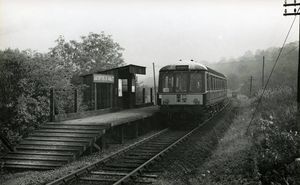Difference between revisions of "Jackfield Halt"
(Featured article) |
(additional info and history) |
||
| Line 11: | Line 11: | ||
Jackfield, on the banks of the River Severn, was particularly noted for pottery and tile making. It also served as a riverside port for nearby [[Ironbridge and Broseley | Broseley]], which was situated high above the river. Today the Jackfield Tile Museum is one of the ten museums of the Ironbridge Gorge Museum Trust. | Jackfield, on the banks of the River Severn, was particularly noted for pottery and tile making. It also served as a riverside port for nearby [[Ironbridge and Broseley | Broseley]], which was situated high above the river. Today the Jackfield Tile Museum is one of the ten museums of the Ironbridge Gorge Museum Trust. | ||
| − | Jackfield Halt opened in December 1934, one of a number of halts opened around that time in a bid to attract more local custom to the line. It consisted of a simple wooden platform with a small wooden shelter. | + | ==Jackfield Halt== |
| + | Jackfield Halt opened in December 1934, one of a number of halts opened around that time in a bid to attract more local custom to the line. It consisted of a simple wooden platform with a small wooden shelter, and was situated to the west (north in the direction of travel) of the nearby sidings of the [[Maw and Co's Siding | Maw & Company]] tile works (now the site of the Jackfield Tile Museum). The location, approximately mid-way between [[Coalport]] and [[Ironbridge and Broseley | Ironbridge]], was adjacent to the level crossing for the road which served the area of the nearby village known as Salthouses.<ref name = "Stretton">[[Bibliography#Books | Stretton (2010), p. 97.]]</ref> | ||
| − | + | The original halt was situated on the Doughty Fault<ref>[[Bibliography#Books | Vanns (1998)]] p.46.</ref> on an area of unstable ground, made worse by the history of clay mining in the area. This caused a number of problems over the years, culminating in a major landslide in spring 1952 when the line and halt slumped 25ft towards the river; many houses in the area were also destroyed. Following this, the halt platform and shelter were relocated by around ¼ mile to a position east of the sidings (south in the direction of travel), re-opening on 1 March 1954.<ref name = "Marshall">[[Bibliography#Books | Marshall (1989), p. 109.]]</ref> Thereafter the area remained subject to further subsidence, requiring regular re-alignment and re-ballasting of the line which was subject to a 5 m.p.h. restriction.<ref name = "Stretton" /> | |
| + | |||
| + | The halt remained in use until the closure of the line to passengers on 9 September 1963. Ongoing subsidence later resulted in the adjacent road being closed and rebuilt on the old track bed, although this was in turn subject to further collapse.<ref name = "Marshall" /> | ||
| + | |||
| + | ==See also== | ||
| + | [[Maps#Schematic_maps_of_the_pre-closure_SVR | Pre-1963 map]] | ||
==References== | ==References== | ||
| − | + | <references /> | |
| − | |||
==Links== | ==Links== | ||
[http://www.britishpathe.com/search/query/jackfield Viewable British Pathe Newsreels of the 1952 landslide ] | [http://www.britishpathe.com/search/query/jackfield Viewable British Pathe Newsreels of the 1952 landslide ] | ||
| − | |||
| − | |||
[[Category:Featured articles]] | [[Category:Featured articles]] | ||
Revision as of 17:05, 15 November 2016

| Towards Hartlebury and Kidderminster | Towards Shrewsbury |
|---|---|
| Coalport | Ironbridge |
Jackfield, on the banks of the River Severn, was particularly noted for pottery and tile making. It also served as a riverside port for nearby Broseley, which was situated high above the river. Today the Jackfield Tile Museum is one of the ten museums of the Ironbridge Gorge Museum Trust.
Contents
Jackfield Halt
Jackfield Halt opened in December 1934, one of a number of halts opened around that time in a bid to attract more local custom to the line. It consisted of a simple wooden platform with a small wooden shelter, and was situated to the west (north in the direction of travel) of the nearby sidings of the Maw & Company tile works (now the site of the Jackfield Tile Museum). The location, approximately mid-way between Coalport and Ironbridge, was adjacent to the level crossing for the road which served the area of the nearby village known as Salthouses.[1]
The original halt was situated on the Doughty Fault[2] on an area of unstable ground, made worse by the history of clay mining in the area. This caused a number of problems over the years, culminating in a major landslide in spring 1952 when the line and halt slumped 25ft towards the river; many houses in the area were also destroyed. Following this, the halt platform and shelter were relocated by around ¼ mile to a position east of the sidings (south in the direction of travel), re-opening on 1 March 1954.[3] Thereafter the area remained subject to further subsidence, requiring regular re-alignment and re-ballasting of the line which was subject to a 5 m.p.h. restriction.[1]
The halt remained in use until the closure of the line to passengers on 9 September 1963. Ongoing subsidence later resulted in the adjacent road being closed and rebuilt on the old track bed, although this was in turn subject to further collapse.[3]